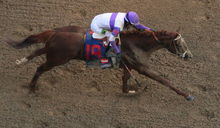A research study into the gaits of horses has found that a mutation has had a major impact on the diversification of gaits in horses as evidenced by altered gait characteristics of a number of breeds.

Mutation responsible for horse gait
Researchers found that a genetic mutation has a major effect on the movement of a horse, particularly gait.
According to a new study published in the journal "Nature" that examined motion in both horses and in mice using a process called “whole genome SNP analysis” during which researchers studied the genes of 70 Icelandic horses that had either four gaits or five, with the pace being the fifth gait.
The research pointed to a gene identified as DMRT3 that is critical for horse motion and limb movement.
Horses have gaits classified in three descriptions of speed: walk, trot, and gallop. Researchers found that DMRT3 has a major effect on the movement of a horse, particularly gait.
“‘Gaitedness’ is a trait that naturally occurs in all horses, but many breeds have been developed for a specific speed or gait,” says Gus Cothran, a professor in the Animal Genetic Lab at Texas A&M University.
The team sequenced the DMRT3 gene of test horses and found in almost every case of gaited horses there was mutation in the DMRT3 that caused a premature “stop codon,” which causes the protein product of the gene to be terminated before the whole protein is completed. This alters the function of the protein, which leads to the differences associated with the gait.
Cothran and colleague also examined the same gene and its effect on mice.
“We specifically looked at the gene and its effect on the movement of mice, such as its swimming ability,” he says. “The motion ability of mice seemed suppressed and was similar, though not identical, to that of gaited horses.”
With more research, the findings could have critical importance to horse breeding and horse racing. Many horses are specifically bred for certain types of gait, such as harness racing.
“We need to examine the DMRT3 on certain breeds and see if it can directly affect the speed and movement of horses,” he adds. “Naturally, it’s something that horse breeders and anyone involved with horse racing would be interested in and would want to know about. These findings could have a major impact on future horse breeding.
“We think it’s an exciting step in looking at motion, speed, and limb movement, and it’s possible it could have implications in other species, too.”
The project was funded by grants from the Swedish Brain Foundation and computer resources were supplied by the Royal Swedish Academy of Sciences Research.
Source of information for news item: Texas A&M University
